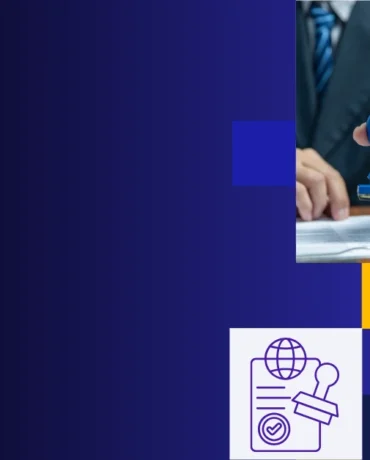All business owners know that effectively managing human resources is crucial for organisational success. For midsize companies, implementing an HRIS System (Human Resources Information System) has become an essential step to streamline HR processes. However, choosing the best HRIS systems for midsize companies poses challenges as there are so many in the market.
An HRIS serves as a central repository for all employee-related data and automates many routine HR tasks. This article explores what an HRIS system entails and why it is particularly vital for small to midsize companies. It also highlights some of the best HRIS systems for midsize companies in 2025.
What are HRIS Systems?
An HRIS is a software system primarily used by HR professionals to store and manage comprehensive employee data. At its core, an HRIS focuses on the tactical and logistical aspects of HR. It centralises information such as employee details, salaries, benefits, organisational charts, and company policies and procedures in one location. Nowadays, to gain a competitive edge, many HRIS systems have implemented AI as one of their core features.
The primary purpose of an HRIS is to automate routine administrative tasks and streamline the management of employee information. This automation helps organisations to be more organised, efficient, and transparent in their HR operations. For instance, it can handle payroll processing, leave management, and the tracking of key employee metrics.
The difference between HRIS, HRMS, and HCM
| Aspect | HRIS (Human Resources Information System) | HRMS (Human Resource Management System) | HCM (Human Capital Management) |
| Core Focus | Data Management & Administration: Serves as a digital system of record for core employee data and automates essential HR functions. | Process & Talent Management: Expands on HRIS to manage a broader range of HR processes and workflows, with a focus on talent and productivity. | Strategic Workforce Optimization: A holistic approach that treats employees as valuable assets (“capital”) to be managed and aligned with overall business goals. |
| Scope | Operational: Primarily focused on automating the day-to-day administrative tasks of the HR department. | Operational & Tactical: Covers core operations and adds tactical tools for managing the employee lifecycle. | Strategic: Encompasses all operational and tactical functions while adding a layer of strategic planning, analytics, and long-term development. |
| Ideal For | Small to medium-sized businesses are transitioning from spreadsheets and manual processes to a centralized system. | Mid-sized to large organizations that need to streamline a wider range of HR processes and manage the employee lifecycle more effectively. | Large, complex, or global organizations that prioritize strategic talent management, workforce planning, and data-driven decision-making. |
| Primary Benefit | Efficient data management, reduced administrative burden, and improved compliance. | Comprehensive automation of HR processes and optimized workflows for better productivity. | Strategic alignment of the workforce with organizational objectives to drive business success and maximize ROI on talent. |
In essence, HRIS is the database component. HRMS adds process management and automation. HCM is a broad, strategic suite that includes everything found in HRIS and HRMS, plus advanced capabilities
Why the HRIS System is Crucial for Midsize Companies
Small to midsize companies often face unique challenges in HR management due to their limited resources and the need for staff to juggle multiple roles. Sometimes, to avoid growing headcounts, businesses often outsource a dedicated team for the project. This needs bespoke software to help them manage their contemporary staff. Without a dedicated HR team or extensive resources, HR-related matters frequently fall to business managers and owners. This can lead to:
- Limited Resources & Administrative Burden: Manually handling HR tasks like payroll, recruitment, and employee records can be time-consuming and error-prone, leading to inefficiencies and compliance risks. Nearly two-thirds of companies surveyed by Paychex reported spending at least 11 hours per week on HR administration.
- Lack of Expertise: Small businesses may not have the specialised HR expertise required to effectively implement and manage complex HR functions.
- Scalability Issues: As a small business grows, its HR needs evolve, and managing this growth without an efficient system can become cumbersome.
- Data Management Challenges: Maintaining accurate and secure employee data is difficult without a centralised system, which is crucial for informed decision-making and compliance.
The Benefits of the Best HRIS Systems
Implementing an HRIS directly addresses these pain points by offering significant benefits:
- Automation: HRIS automates routine HR tasks such as payroll processing, leave management, and employee records, freeing up valuable time. This can significantly reduce administrative workload.
- Improved Accuracy and Compliance: Automated systems reduce the risk of human error in data entry and calculations, leading to more accurate and reliable HR management. This also helps ensure compliance with labour laws and regulations by maintaining accurate records and generating necessary reports.
- Better Data Management and Security: A centralised HRIS provides a single source of truth for employee information, improving data accessibility and security. Robust security measures, including encryption and access controls, protect sensitive employee information from unauthorised access and cyber threats.
- Scalability: HRIS systems can scale with a growing small business, accommodating increasing HR needs without breakdowns, unlike manual systems.
- Reduced Administrative Costs: By eliminating manual processes and increasing efficiency, the HRIS systems can help reduce administrative costs.
Key Features of the HRIS Systems Tailored for Midsize Companies
When selecting an HRIS for a small business, certain features are particularly beneficial:
- User-Friendly Interface: Intuitive and easy-to-navigate interfaces are crucial for midsize companies to reduce the learning curve and ensure ease of use.
- Core HR Functions: Essential features include employee record management, payroll processing, and leave tracking, which are fundamental for day-to-day operations. According to Gartner, 46% of HR software buyers seek built-in payroll functionality, and 40% desire time and attendance features.
- Recruitment and Onboarding Tools: Features for managing job postings, applications (Applicant Tracking System – ATS), and onboarding processes streamline hiring and new employee integration.
- Employee Self-Service Portals: These allow employees to manage their information, request time off, and view pay stubs, significantly reducing the administrative burden on HR.
- Reporting and Analytics: Basic tools provide insights into key HR metrics like turnover rates and employee performance, enabling data-driven decisions.
- Integration Capabilities: Seamless integration with existing systems (e.g., payroll, time and attendance, benefits platforms, accounting software) is vital for smooth data flow across the HR ecosystem.
- Security and Compliance: Robust security measures such as role-based access control, data encryption, and audit trails are critical to protect sensitive employee data and ensure adherence to regulations.
- Mobile App Accessibility: Many modern HRISs come with mobile capabilities, enabling HR professionals and employees to access core functionalities on the go.
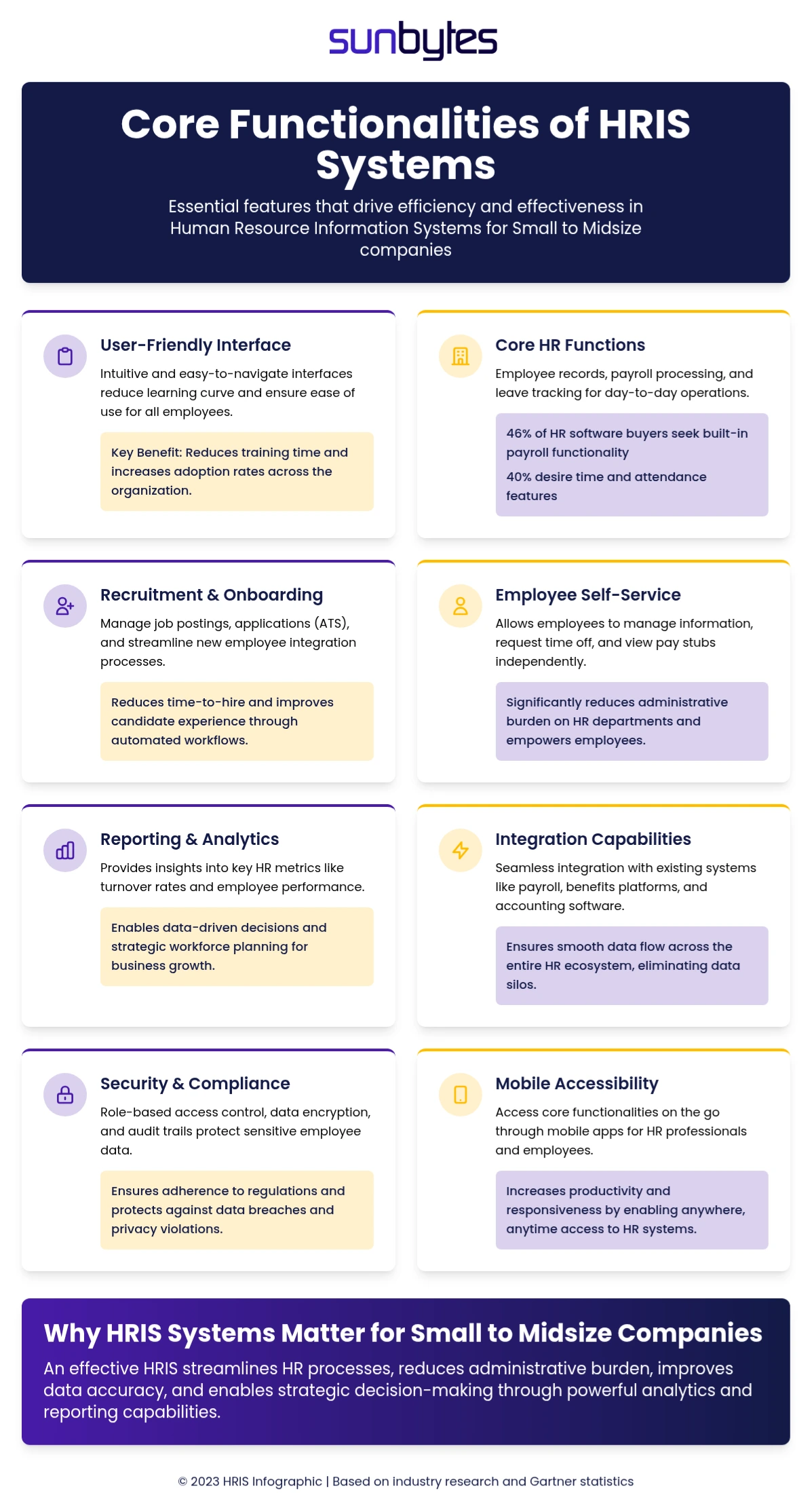
10 Best HRIS Systems for Midsize Companies in 2025
The HR software market is experiencing significant growth, with SMEs holding a substantial 62% of the market share in 2021. The adoption of cloud-based HR solutions by SMEs is driven by their cost-effectiveness, reduced labour costs, increased employee productivity, and improved user accessibility. Many solutions for SMBs operate on a per-person, per-month (PEPM) pricing model.
So the question is: what are the best HRIS systems for midsize companies out there? There are several, but we’ve listed them out for you:
Deel: Best for managing global teams and international contractors
Deel is an HR platform designed to simplify hiring, payroll, and compliance for a distributed workforce. Currently, our HR services have already integrated Deel’s functions to manage payroll and global contractor management, and it works amazingly. It streamlines the complexities of managing employees and contractors in multiple countries.
- Features: Deel’s platform includes global payroll processing in multiple currencies, benefits administration with localized perks, and automated compliance with local tax and labor laws. It offers tools for onboarding, document management, time tracking, and provides salary insights to help create competitive offers. A core HRIS suite is included at no extra cost with any of its main products.
- Pricing: Deel’s pricing is modular:
- Global Payroll: Starts at $29 per employee per month.
- US Payroll: Starts at $95 per employee per month.
- Deel is highly beneficial for midsize companies looking to expand their workforce globally without the high administrative overhead. It allows small companies to hire talent anywhere in the world, managing contracts, compliance, and payments through a single platform, which is a cost-effective and efficient way to scale internationally.
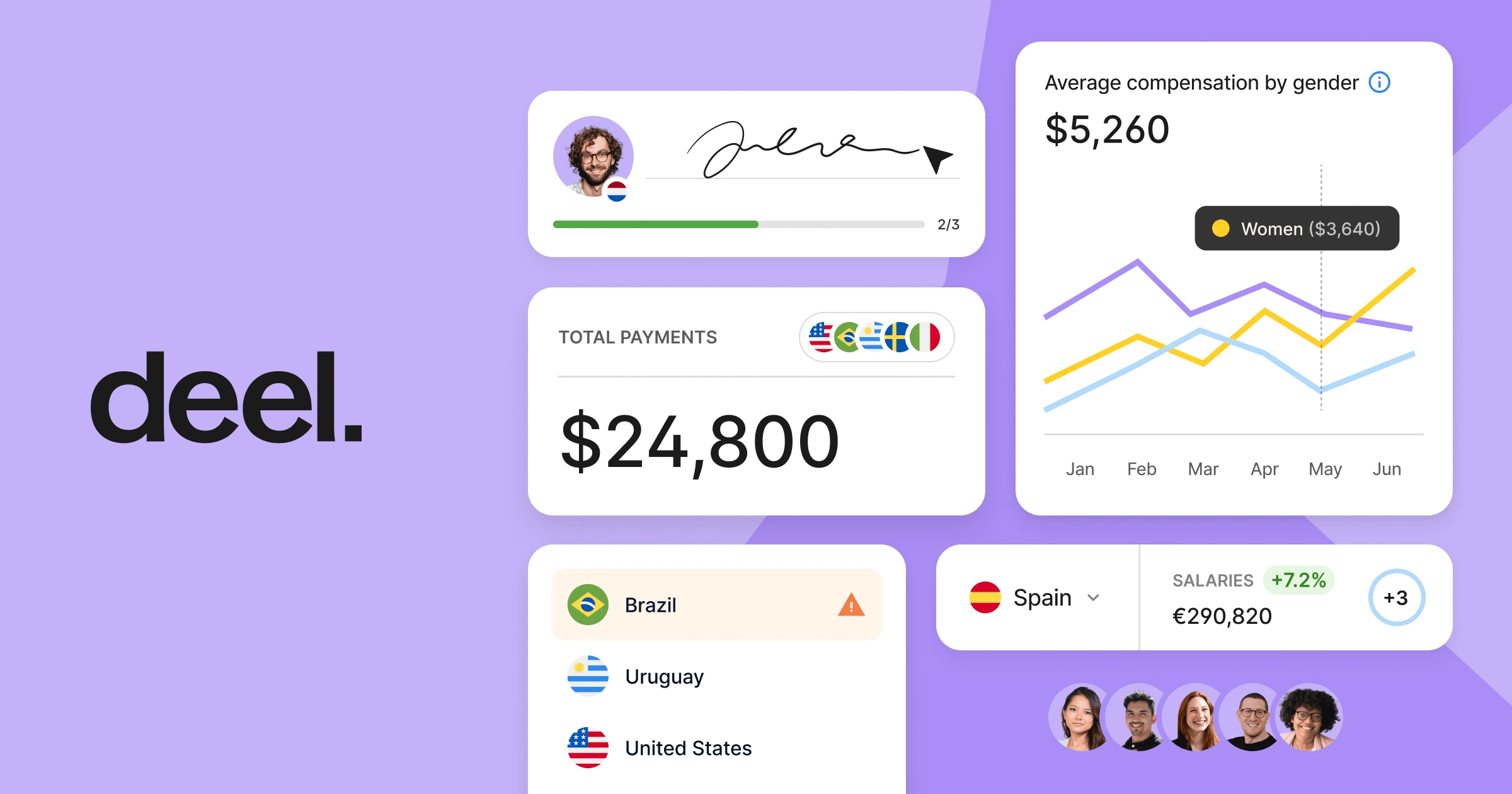
Multiplier: Great for global employer of record (EOR) services
Multiplier enables companies to hire global talent without establishing local legal entities by acting as an Employer of Record (EOR). It also provides tools to manage payroll and benefits for existing international teams.
- Features: The platform’s key features include instant, locally compliant employment contracts, multi-currency payroll, and benefits administration. Multiplier gives employers a self-service web app to manage their global teams, with access to dashboards, timesheets, and invoices.
- Pricing:
- Paying Freelancers: $40 per month.
- EOR Services: Starts at $400 per month for full-time employees in countries where you don’t have an entity.
- For small to midsize companies, Multiplier removes a major barrier to global expansion: the need to incorporate in every country they hire from. This significantly lowers costs and speeds up the hiring process, allowing small businesses to access a global talent pool quickly and compliantly.
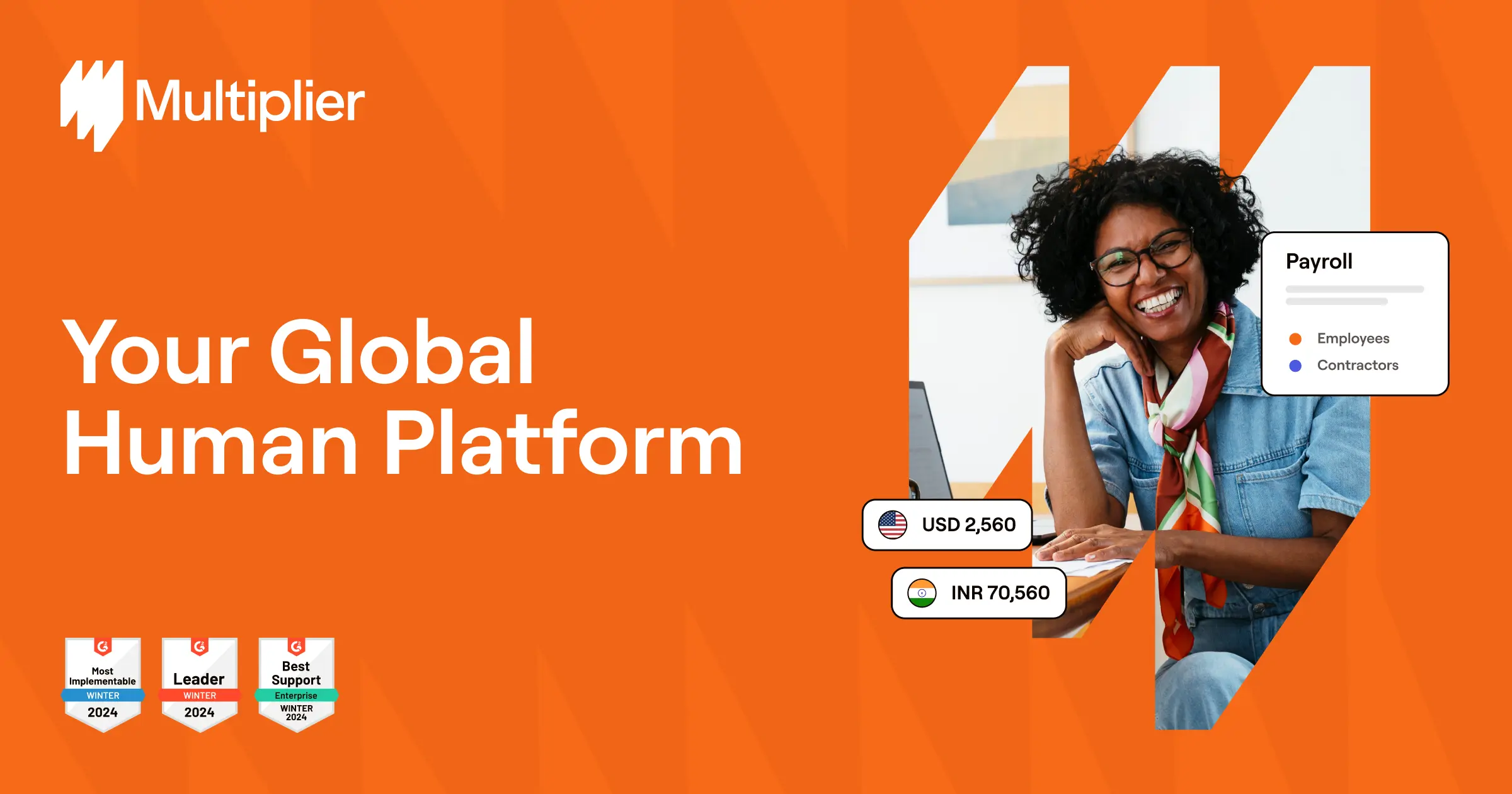
BambooHR: Best for user-friendly, all-in-one HR management
BambooHR is a comprehensive and intuitive HR software that centralizes all employee data, from hiring and onboarding to payroll and offboarding.
- Features: BambooHR offers core HR functionalities like an employee database, benefits administration, time tracking, and payroll. It also provides tools for performance management and boasts a marketplace with over 150 integration partners.
- Pricing: BambooHR’s pricing is customized. For businesses with 25 or fewer employees, it offers a flat monthly rate. For larger companies, it uses a per-employee, per-month model with volume discounts automatically applied as the company grows. Nonprofits receive a 15% discount.
- The flat-rate pricing for very small companies makes BambooHR highly accessible and budget-friendly. Its user-friendly interface reduces the learning curve, and its all-in-one nature helps growing businesses consolidate their core HR processes efficiently without needing a large HR team.
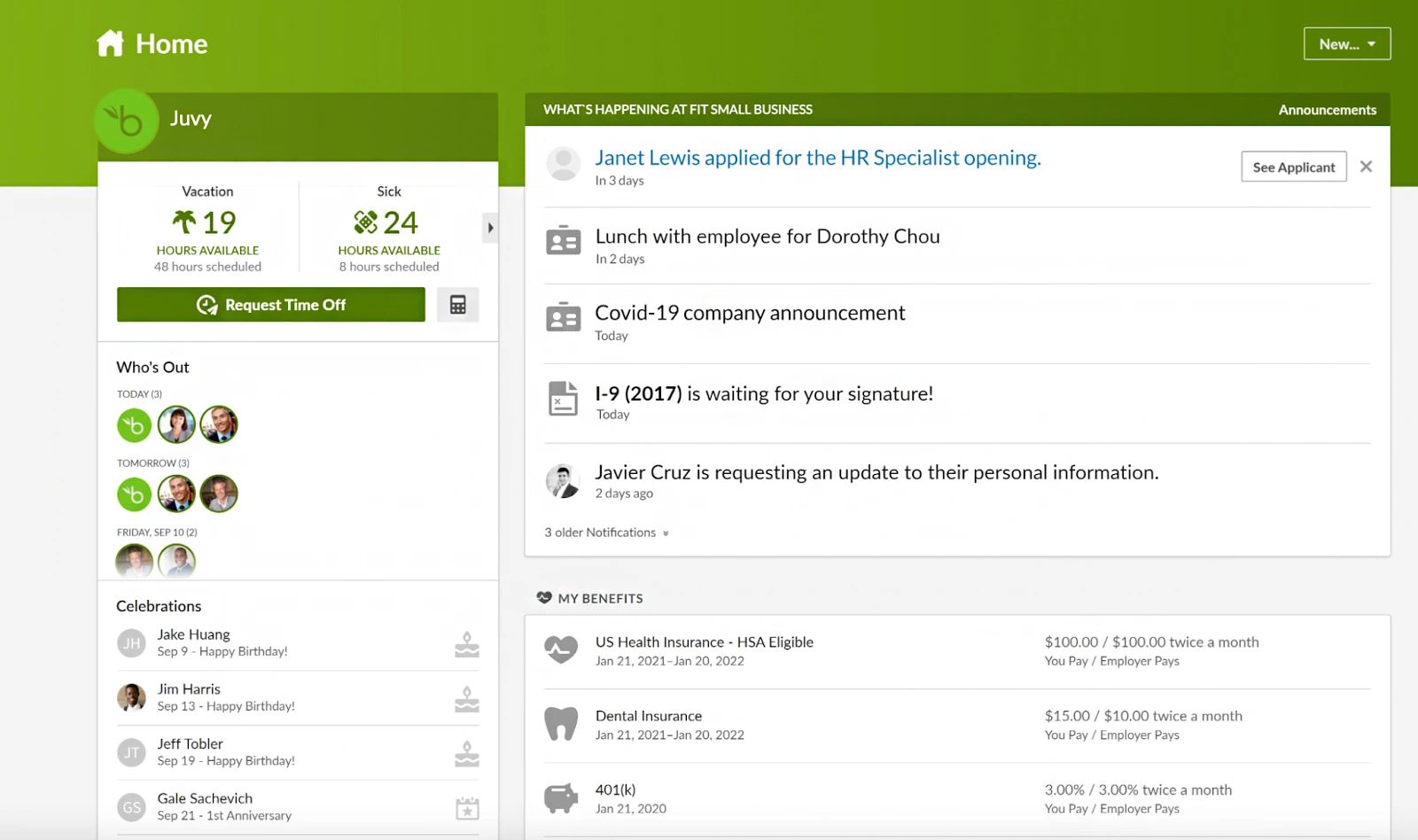
Workday: Great for scaling midsize companies needing advanced analytics
Workday is a powerful, enterprise-grade platform that unifies HR, finance, planning, and analytics into a single system. While often seen as a solution for large corporations, Workday offers tailored packages for midsize companies to large enterprises.
- Features: The platform provides advanced tools for financial management, human capital management (HCM), and enterprise planning. It leverages AI and machine learning to offer deep analytical insights and help automate processes.
- Pricing: Workday does not publish its prices publicly, but it is considered a premium solution. It offers fixed-fee and fixed-scope deployment packages to make costs more predictable for midsize companies.
- Workday is best suited for larger, high-growth enterprises that can leverage its advanced analytics and unified system to drive strategic decisions. While 75% of its customers have fewer than 3,500 employees, its complexity and cost make it less ideal for startups or very small businesses, who may be better served by more streamlined, budget-friendly options.
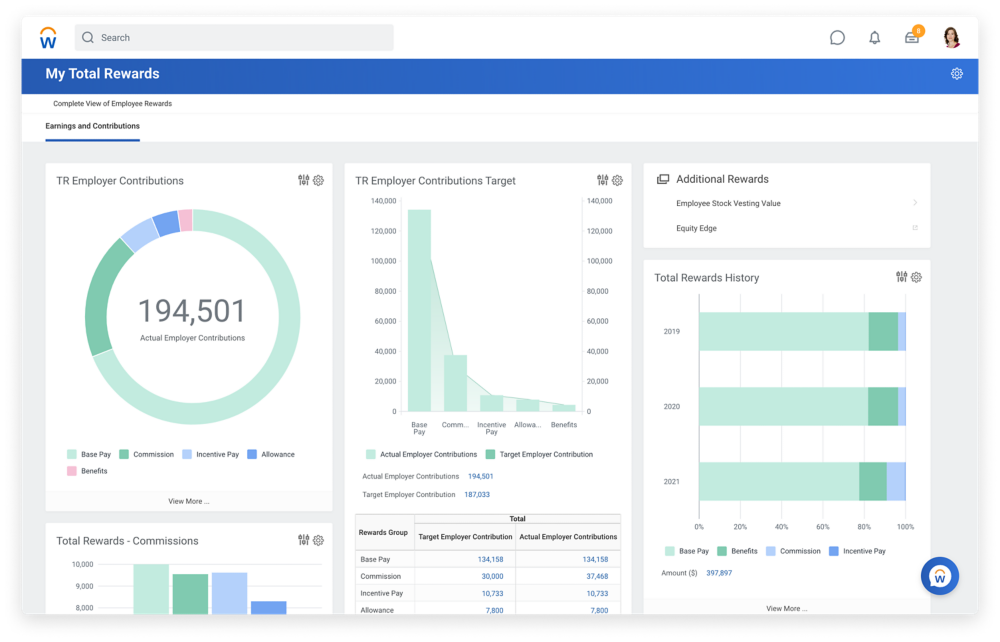
Gusto: Best for all-in-one payroll, benefits, and HR for US-based small businesses
Gusto is an all-in-one platform that combines payroll, benefits, and core HR tools, specifically designed for small businesses in the U.S.
- Features: Gusto offers full-service, multi-state payroll with tax filing, employee self-service portals, and benefits administration (health, 401(k), workers’ comp). It also includes tools for hiring, onboarding, time tracking, and performance management. Its Payroll on AutoPilot® feature can run payroll automatically.
- Pricing: Gusto has a transparent, tiered pricing model:
- Simple Plan: $59/month base fee + $8/month per person.
- Plus Plan: $99/month base fee + $14/month per person.
- Gusto is built for small businesses. It’s an all-in-one platform that simplifies complex tasks like payroll and compliance, saving valuable time for business owners. The user-friendly design empowers employees to manage their information, and the transparent pricing makes it easy for small to midsize companies to budget their HR costs.
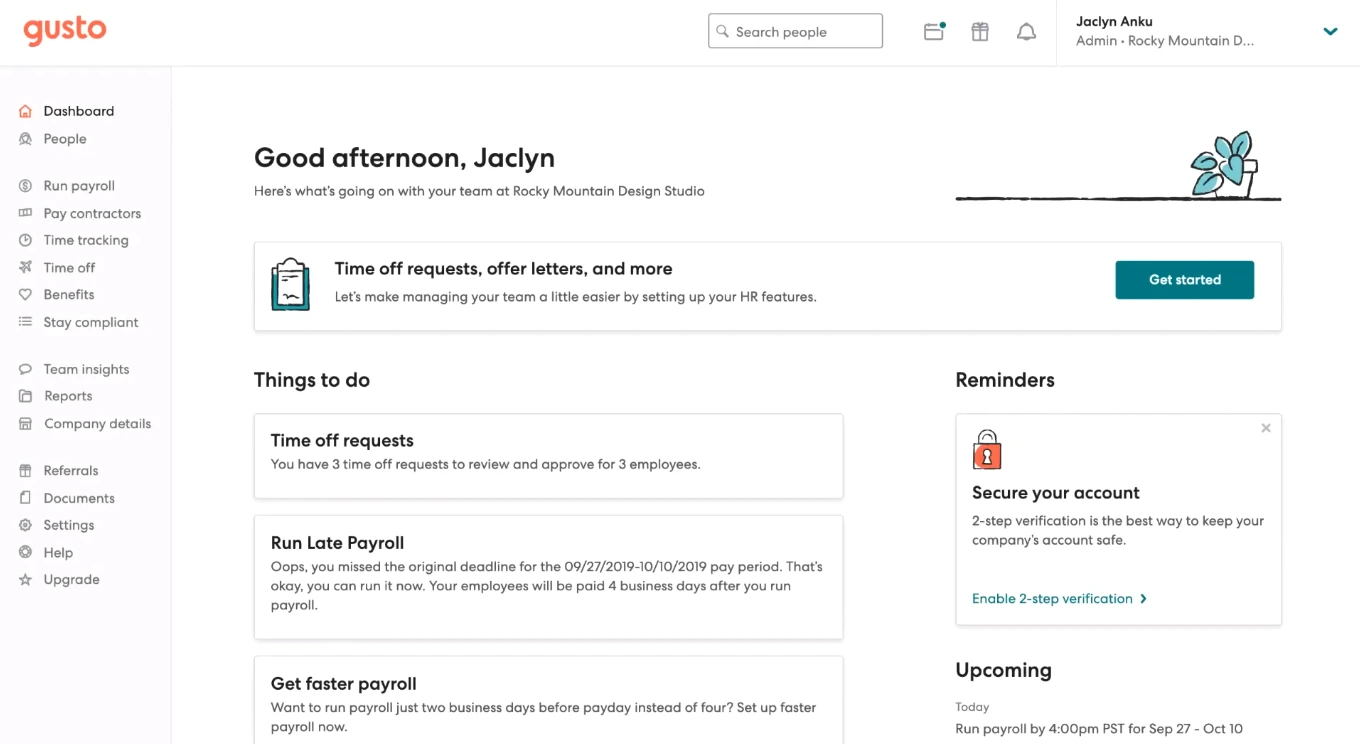
HRplan: Great for affordable and simple core HR management
HRplan is a focused and affordable HR software designed to help growing businesses manage essential HR processes without unnecessary complexity.
- Features: Its core features include a centralized employee database, time-off management, expense and advance tracking, and asset management (like laptops and phones). The platform prioritizes data security and compliance with legal regulations.
- Pricing: HRplan positions itself as an affordable solution for growing businesses and offers a 30-day free trial. Specific pricing details are available upon inquiry.
- HRplan is ideal for small businesses that need a simple, low-cost tool to digitize their core HR functions like leave and expense tracking. Its focused feature set avoids the bloat of larger systems, making it easy to implement and use for companies just beginning to formalize their HR processes.
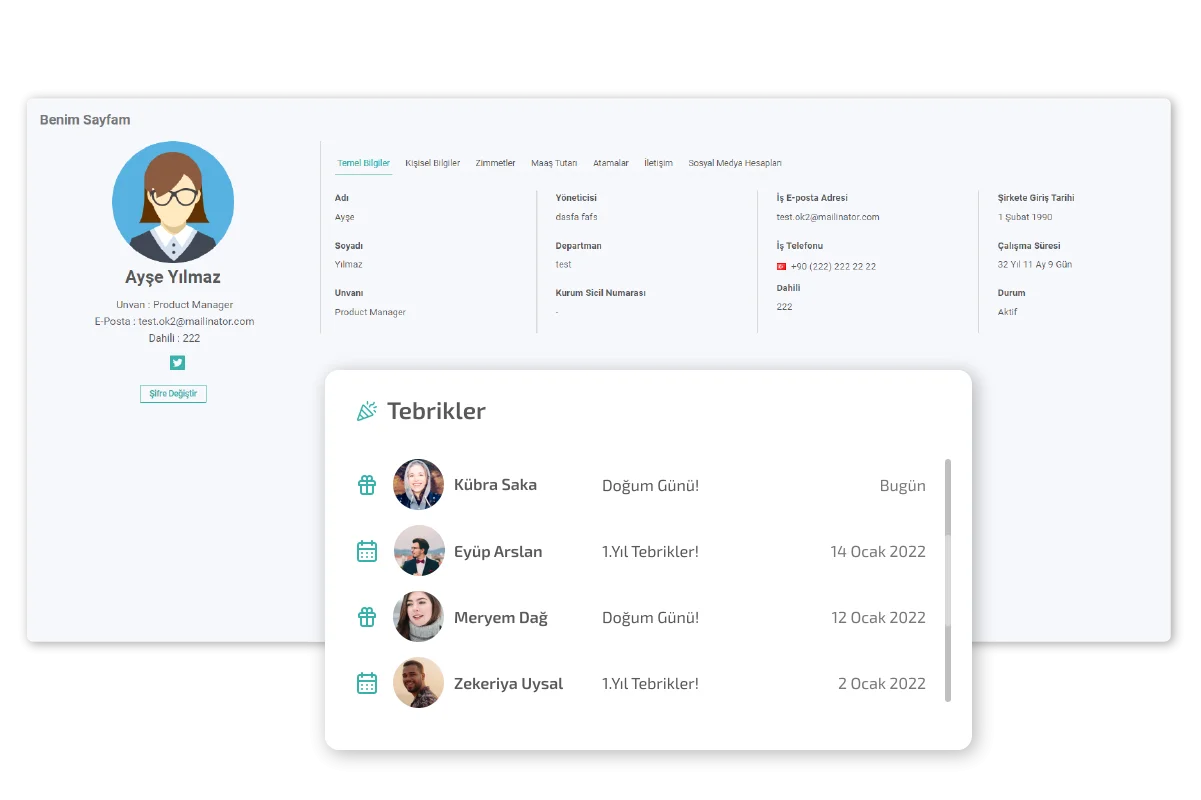
Omni: Great for businesses with a presence in Asia
Omni is an all-in-one HR platform that specializes in serving companies operating across multiple countries in Asia. It integrates HR and payroll with a deep understanding of the region’s diverse compliance and cultural needs.
- Features: Omni provides a unified system for hiring, onboarding, performance reviews, time off, and multi-country payroll. It offers locally compliant payroll, support in multiple languages, and customizable workflows to automate HR tasks.
- Pricing: Omni offers its HR automation platform for as low as $3 per employee per month.
- Omni is a standout choice for midsize companies operating or expanding in Asia. Its platform is “built for multi-country Asia,” not just a Western system with tweaks, ensuring local compliance and understanding. The low price point and automation features help small businesses manage a regional workforce efficiently.
Wanting to expand your business in one of Asia’s fastest-growing markets? Read this: Top Mistakes When Setting Up Your Business in Vietnam
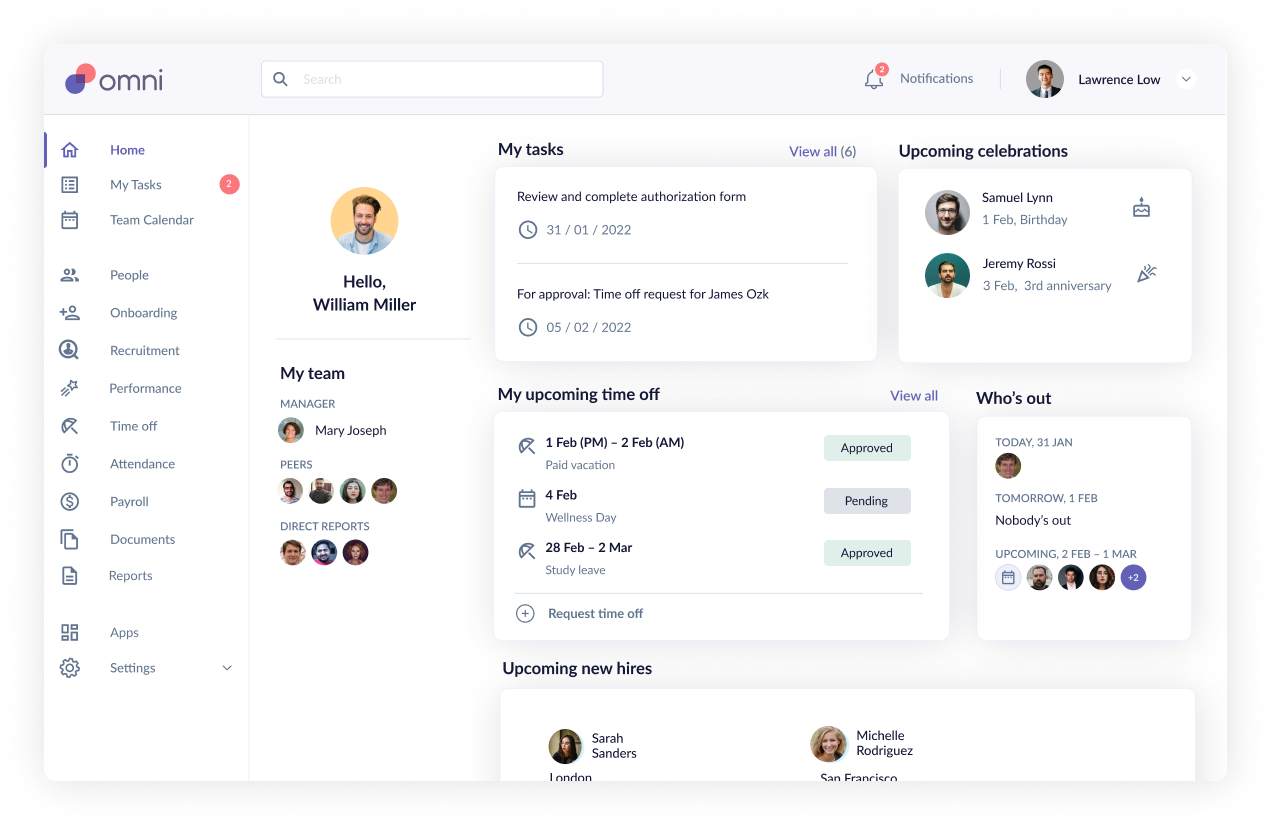
Remote: Best for simplifying global employment and compliance
Remote is a global HR platform focused on enabling companies to hire, manage, and pay international employees and contractors from a single hub. It acts as an EOR to handle the legal complexities of global employment.
- Features: Remote handles international onboarding, payroll, benefits, and compliance, ensuring adherence to local labor laws in every country of operation. This eliminates the need for companies to set up their local entities.
- Pricing: Remote emphasizes transparent pricing with no hidden fees, positioning itself as a cost-effective alternative to investing in complex HRIS software for global operations.
- Remote is perfect for companies that want to hire the best talent globally without getting bogged down by legal and administrative hurdles. By handling all the compliance and payroll complexities, Remote allows small businesses to focus on growth and manage a distributed team confidently and efficiently.
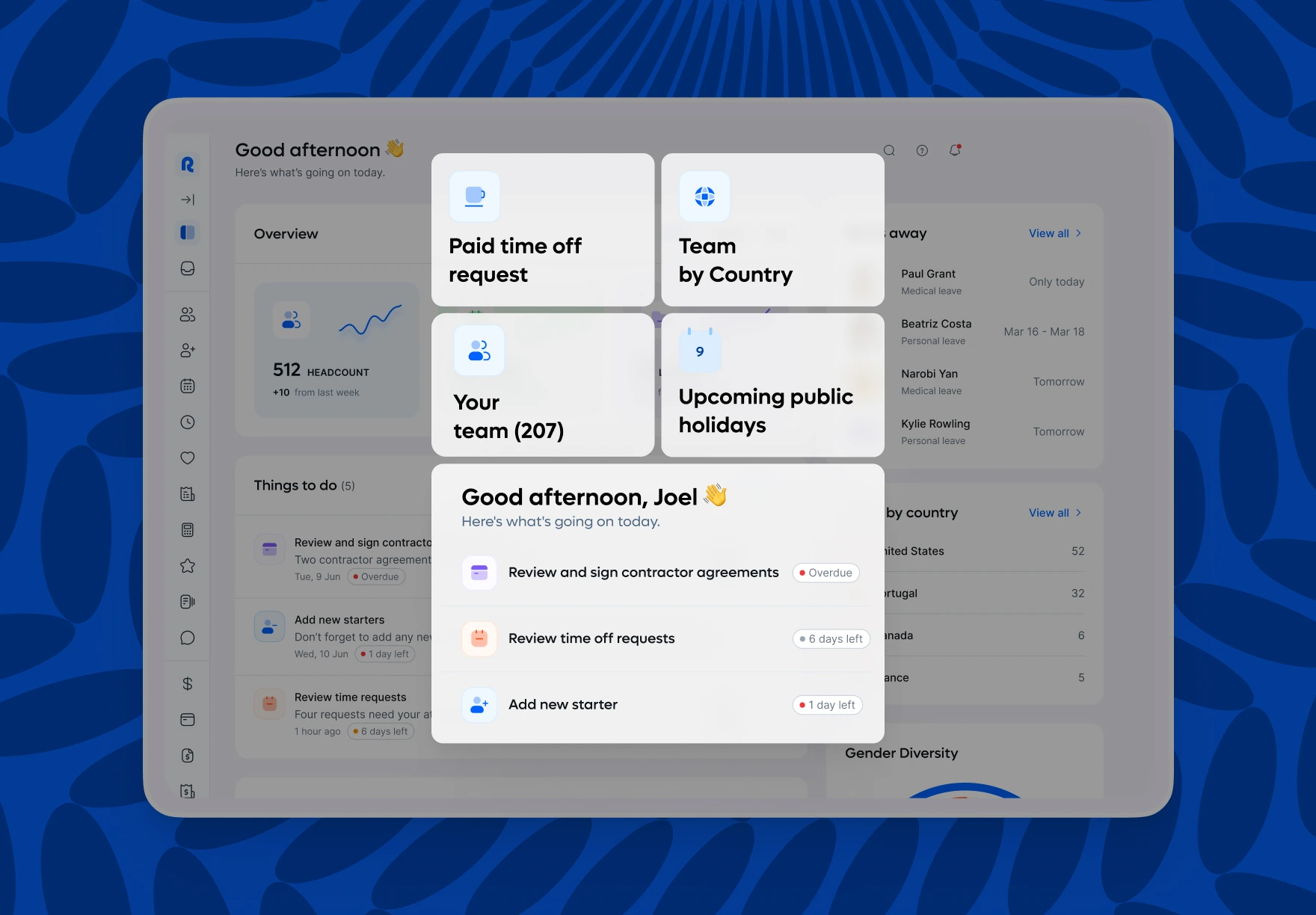
Justworks: Great for PEO services and benefits access
Justworks is a Professional Employer Organization (PEO) that provides an all-in-one solution for HR, payroll, benefits, and compliance, primarily for U.S.-based small businesses.
- Features: Justworks combines simple HR software with access to enterprise-level benefits (medical, dental, vision), automated payroll, and compliance support. It includes tools for document management, e-signatures, and HR reporting and analytics.
- Pricing: Pricing is available upon request after answering a few questions about the business’s needs.
- Justworks is one of the best HRIS systems for midsize companies that want to offer competitive benefits to attract and retain talent but lack the scale to secure good rates on their own. Bundling HR, payroll, and compliance with high-quality benefits allows small business owners to offload administrative burdens and focus on growing their company.

Rippling: Best for unifying HR, IT, and Finance in one platform
Rippling is a unique platform that unifies employee data across HR, IT, and Finance, allowing businesses to manage everything from payroll and benefits to employee apps and devices in one place.
- Features: Rippling’s core is its Unity Platform, which serves as a single source of truth for all employee data. On top of this, it offers modular products for payroll, benefits, time tracking, and talent management. A key differentiator is its IT management capability, which can automatically provision or deprovision employee software and devices during onboarding and offboarding.
- Pricing: Rippling plans start at $8 per user per month. The platform is modular, so businesses can purchase only the products they need alongside the required core platform.
- Rippling is exceptionally well-suited for tech-savvy companies that want to automate administrative work across departments. The ability to manage HR and IT tasks from a single trigger (e.g., hiring a new employee automatically creates their email, Slack, and payroll accounts) saves immense time and reduces manual errors, making it a powerful efficiency tool for growing companies.
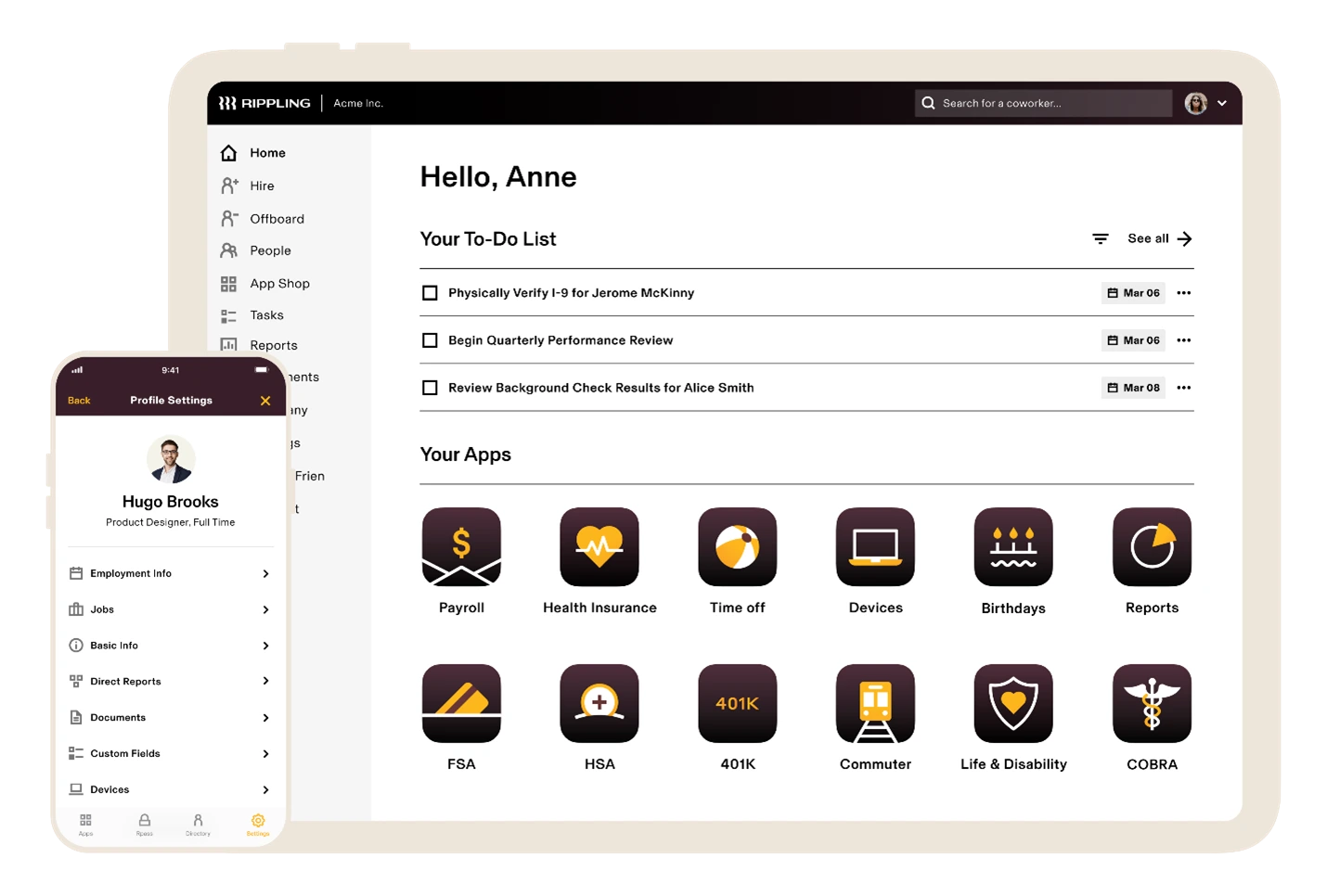
In conclusion, the best HRIS systems for midsize companies are HRPlan, Justworks, Deel, Omni (for Asian businesses), or Gusto (for American businesses). They work magic for small to midsize companies with limited resources. Additionally, if your business needs scaling (growing headcounts, global workforce management, or an advanced HCM suite), go for options like Multiplier, BambooHR, Workday, Remote, and Rippling.
Implementing HRIS Successfully
Implementing an HRIS system requires meticulous planning and execution to ensure alignment with an organisation’s unique needs and objectives. A report by J. Bersin estimates that over 40% of implementations fail within two years. It’s often due to poor advanced planning, stakeholder alignment, change management, and a lack of expertise.
Key steps for successful HRIS implementation in SMEs include:
Define Needs and Set Goals
Identify current HR challenges and set specific, measurable, achievable, relevant, and time-bound (SMART) objectives for the HRIS implementation. For example, centralising employee data to reduce inconsistencies by 90% or automating payroll to reduce processing time by 50%.
Assemble Your Dream Team
Even for SMEs, assembling a cross-functional team is critical. This could include a Project Sponsor, Project Manager, HR Representative, Payroll Specialist, End-User Representatives, and potentially a Fractional HRIS Consultant to reduce costs.
Conduct a Comprehensive Needs Assessment
This involves process mapping, technology audits, user interviews, data analysis, and compliance review to understand specific requirements and future aspirations. Consider whether the HRIS needs to expand to a full HCM suite in the future.
Choose the Right HRIS System
Evaluate systems based on core functionality, scalability, user experience, integration capabilities, customisation options, reporting, security, vendor support, total cost of ownership, and future expansion potential.
Develop a Detailed Project Plan
Create a comprehensive roadmap outlining project phases (planning, design, configuration, testing, training, go-live), timelines, resource allocation, budget, risk management, change management, and success metrics.
Data Migration and Integration
This is often the most challenging aspect. Conduct thorough data audits and cleansing, create detailed data mapping, and consider a phased approach for migration. Plan seamless integrations with other critical systems like payroll, time and attendance, and applicant tracking systems.
Customise and Configure
Adapt standard forms, configure workflows, set up security and permissions, design dashboards and reports, and configure employee self-service. However, balance customisation with maintainability to avoid complex future upgrades.
Train Your Team
Implement comprehensive, role-based training programs using a blended learning approach. Consider “train-the-trainer” models and plan for continuous learning and feedback loops to ensure user adoption.
Test Thoroughly
Conduct rigorous testing across all phases: unit testing, integration testing, system testing, user acceptance testing (UAT), performance testing, security testing, data migration testing, and regression testing.
Go Live and Maintain
Develop a comprehensive go-live checklist, communicate extensively with stakeholders, prepare support resources, conduct final data validation, and provide “hypercare” support during the initial post-launch period. Ongoing monitoring, issue resolution, and training are vital for long-term success.
Choosing the best HRIS systems for midsize companies is a daunting task. However, when done right, a Human Resources Information System (HRIS) can positively contribute to your HR operations, leading to greater efficiency, accuracy, and scalability. Ultimately, strategic investment in the right HR system and a well-executed implementation plan will yield significant improvements in both HR operations and overall business performance.


